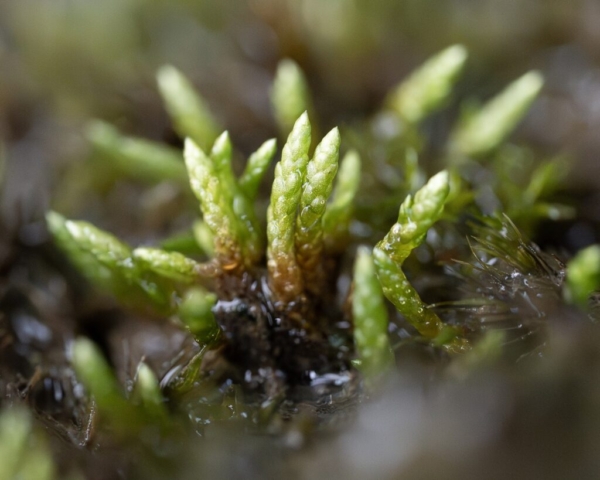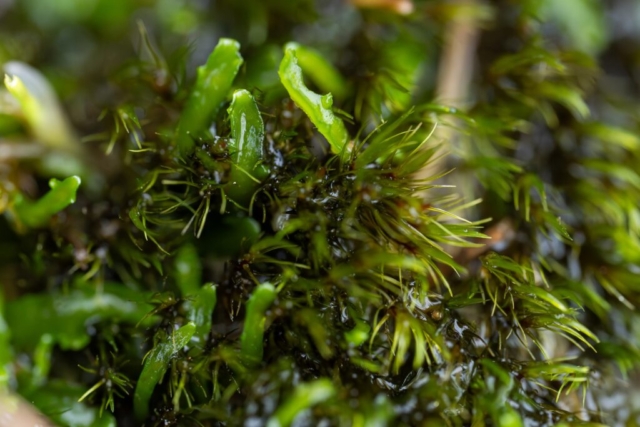As with any bryology outing, it’s easy to get distracted by the surroundings of the car park. Some awkward road closures and traffic spread out arrivals, so a brief look around Pendragon castle yielded a light green Zygodon growing on an old ash – Zygodon rupestris perhaps? Alas, the longitudinal cell walls on its gemmae confirmed it as the more-common Zygodon viridissimus.
Once all three bryologists were present, we set off for the Mallerstang crags aiming to focus our efforts on grid square NY7902 which curiously lacked any bryophyte records. After confirming the presence of Rhytidiadelphus squarrosus ambitiously (presumptively?) identified by Judith from 800m away in the car park, we found a typical assembly of upland acid grassland mosses and the first few of what would be a good day for Sphagnum – Sphagnum capillifolium, S. subnitens and S. russowii.
Our first liverwort of the day was Tritomaria quinquedentata growing among wefts of Pleurozium and Pseudoscleropodium, quickly followed by Ptilidium ciliare, Orthocaulis attenuatus and a larger gemmiferous Orthocaulis (confirmed later as O. atlanticus) on the grassy margins of exposed rocks. The shaded bases of the larger rocks were occupied by Diplophyllum albicans, Scapania gracilis and the occasional large stand of a Cephalozia, later confirmed by Kerry to be C. bicuspidata.
As we advanced further towards the crags, we crossed several rush-dominated flushes, adding six more sphagna to our list – S. squarrosum, S. auriculatum, S. palustre, S. fallax, S. angustifolium and S. teres. We also added Polytrichum commune whose family was well represented on the day, including P. piliferum, P. strictum, P. formosum, Polytrichastrum alpinum, Pogonatum urnigerum and P. aloides.
We passed a few more damp patches adding Sphagnum papillosum and S. rubellum to our list, and our arrival at the crags was further delayed by a stream with typical riparian bryophytes – Brachythecium plumosum, Racomitrium aciculare, R. aquaticum, Scapania undulata and a Pellia species. The flushed edges boasted Philonotis fontana and Dichodontium pellucidum with scattered patches of Riccardia chamaedryfolia.
It was after 2pm when we reached the crags where we pondered a slender Campylium, later identified as C. portensum with leaves <2mm long, large alar patches and abruptly tapering leaves. The flushed crags were adorned with flows of the usual suspects – Philonotis fontana, Amphidium mougeotii, Palustriella commutata and Breutelia chrysocoma. The diversity expanded with Pohlia wahlenbergii, Bryum julaceum, Aneura pinguis, Pellia endiviifolia with ample branchlets, Blindia acuta, Jungermannia atrovirens, Hookeria lucens and Gymnostomum aeruginosum.
Our journey back to the carpark included a brief stop around some boulders with Calypogeia arguta, Schistidium crassipilum and Orthotrichum diaphanum joining our list. Further down, a quick look around a streamside limestone exposure yielded little more of interest but hiding in turf overhang was Sphagnum girgensohnii, our twelfth and final Sphagnum of the day.
Text and photos: Paul Ross




















